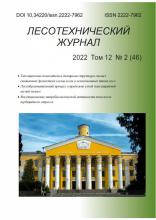Mytischi, Moscow, Russian Federation
Mytischi, Moscow, Russian Federation
Torrefication is a process of low-temperature pyrolysis of wood, used to improve the properties of wood fuel. Torrefied fuel has several advantages compared to the original. Thermal degradation causes changes in mass and composition of wood with increase in carbon percentage, which leads to an increase of combustion value Q. Thermal destruction can be viewed as a multistage process. The degree of decomposition of the material depends on temperature, time of exposure to heat and kinetic parameters of each stage of the process. The article presents the results of experimental studies of combustion value of torrefied woody biomass and its dependence on the degree of thermal decomposition. For experimental studies experimental setup was designed and manufactured. Experimental checking of the installation was carried out. The test showed that accuracy of determining combustion value is not more than 2 %. For experimental studies of the dependence of combustion value on the degree of thermal degradation, samples of wood were prepared in its unsaturated decomposition. Heat treatment of samples was carried out in inert gas environment of helium. Values of heat combustion of wood fuel with varying degrees of thermal destruction are obtained. Model of the dependence of calorific value from relative mass of wood fuel ω is proposed. The mathematical model allowing to determine the relative mass of wood as a function of temperature and time is represented. Dependence of combustion value on degree of thermal decomposition of wood is obtained in explicit form.
torrefication, combustion value, thermal degradation, kinetic parameters.
Рост промышленности и экономики неразрывно связан с доступностью энергоресурсов и развитием энергетики. В настоящее время наблюдается стабильный рост добычи углеводородных ресурсов – газа и нефти. Однако их запасы ограничены. Это приводит к постановке задачи более широкого использования возобновляемых и нетрадиционных источников энергии. Одним из решений является развитие биоэнергетики, предполагающее внедрение новых технологий, разработки и внедрения новых видов топлив, получаемых из биомассы. Свойства топлив, вырабатываемых из биомассы, зависят от свойств исходного сырья и технологии обработки.
В настоящее время в мире доля биоэнергетики составляет до 14 % от общего энергопотребления и продолжает увеличиваться. Существуют прогнозы, показывающие увеличение вклада биомассы до 23,8 % к 2040 г. Один из видов биомассы получают из древесины.
1. Ermochenkov M. G. Kinetika termicheskoy destruktsyi drevesiny v srede inertnyh gazov [Kinetics of thermal degradation of wood in inert gases]. Voronezh: Logging journal, 2016, no. 4 (24), pp. 168-172.
2. Safin R.R. Termomodifitsirovanie drevesiny v srede topochnyh gazov [ermomodifitsirovanie wood in flue gas environments]. Moscow state forest university bulletin - Lesnoy vestnik, № 4 (73), 2010, pp. 115-119.
3. Perederiy S. Kakie pellety luchshe: chernye ili belye? [What better pellets: black or white?]. SPb.: Lesprominform,
4. Zhigunov S.V. Teplomassoobmen i kinetika termodestruktsyi pri vysokotemperaturnom nagreve kompozitsionnyh materialov [Heat and mass transfer and kinetics of thermal degradation at high temperature composite materials] diss. … kand. tekhn. nauk [.dis. ... Cand. tehn. sciences]. Moscow, 1990.
5. Kislitsin A.N. Piroliz drevesiny: himizm, kinetika, produkty, novye protsessy [Pyrolysis of Wood: chemistry, kinetics, products, new processes]. Moscow: Lesnaya promishlennost [Forest Industry], 1990, 312 p.
6. Ermochenkov M. G. Prognozirovanie svoystv termicheski modifitsirovannoy drevesiny [Predicting the properties of thermally modified wood]. Moscow State Forest University Bulletin - Lesnoi Vestnik, 2010, № 4 (73), pp.111-115.
7. Shvedov B.A. Energo- i massoobmen v materialah teplovoy zashity mnogorazovyh raketno-kosmicheskih system: [Energy and mass transfer in thermal protection materials reusable space-rocket systems]: diss. … doct. Tekhn. Nauk [diss. ... Doctor. tehn. sciences]. Moscow, 1990. 8. Peters, B; Bruch, C Drying and pyrolysis of wood particles: experiments and simulation JOURNAL OF ANALYTICAL AND APPLIED PYROLYSIS, 2003. - Vol. 70. - Is. 2. - Pp. 233-250. Number of article: PII S0165-2370(02)00134-1
8. Peters, B; Bruch, C Drying and pyrolysis of wood particles: experiments and simulation JOURNAL OF ANALYTICAL AND APPLIED PYROLYSIS, 2003. - Vol. 70. - Is. 2. - Pp. 233-250. Nomer stat'i: PII S0165-2370(02)00134-1
9. Slopiecka, Katarzyna; Bartocci, Pietro; Fantozzi, Francesco. Thermogravimetric analysis and kinetic study of poplar wood pyrolysis / 3rd International Conference on Applied Energy (ICAE) Perugia, ITALY, 2011. - APPLIED ENERGY, 2012. - Vol. 97. - Is. - Pp. 491-497.
10. Grieco, Enrico; Baldi, Giancarlo. Analysis and modelling of wood pyrolysis / CHEMICAL ENGINEERING SCIENCE, 2011. - Vol. 66. - Is. 4. - Pp. 650-660. DOI: https://doi.org/10.1016/j.ces.2010.11.018; EDN: https://elibrary.ru/OBDTKH
11. Ranzi, Eliseo; Corbetta, Michele; Manenti, Flavio. Kinetic modeling of the thermal degradation and combustion of biomass / CHEMICAL ENGINEERING SCIENCE, 2014. - Vol. 110. - Pp. 2-12.
12. Sarvaramini, A.; Assima, Gnouyaro P.; Larachi, F. and etc. Dry torrefaction of biomass - Torrefied products and torrefaction kinetics using the distributed activation energy model / CHEMICAL ENGINEERING JOURNAL, - Vol. 229. - Pp. 498-507. 2012, pp. 158-164.












